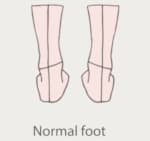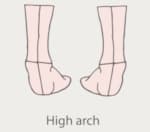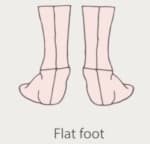The human foot is a complex system, and sometimes it’s not easy to find the shoes that work for you. But some famous brands have developed their shoe finder tool to help you find your best shoes. You just need to provide your gait type and specify what you are training for.
If you are not familiar with the sequence of your foot movements, a gait analysis can help identify posture-related problems and help you run more efficiently.
Types of Pronation of the Foot
To reduce the risk of pain and injury when running, you should understand how your foot moves and lands during the gait cycle. Understanding your foot type will help you find the shoes with the right support for you.
1. Neutral Pronation

Neutral pronation occurs when your foot has a normal, healthy movement. The outside of your heel makes the first touch during heel strike, rolls inward to absorb shock and support your body weight, then pushes off at the ball of the foot distributing weight evenly (with more emphasis on the big toe) among all of the toes at the end of your step. Neutral pronation aligns your lower limb on a straight line.
What are the best shoes for neutral pronation?
The best shoes for neutral pronation are neutral shoes. These shoes can encourage a more natural foot motion and help keep the body properly aligned for efficient running. Neutral runners may also choose to wear minimalist shoes.
2. Supination (also known as Underpronation)

Supination occurs when the outer side of your heel touches the ground at an increased angle, transferring your body weight to the outside of your foot. The supinated foot motion has little to no inward roll so that the shock can radiate through your lower leg. Your weight stays on the outside of your foot, transferring pressure to your smaller toes during the toe-off phase.
What are the best shoes for supination?
Those who supinate may choose to wear any cushioned shoes. But the supinated foot motion is rigid during different phases of the gait cycle, so it needs a flexible shoe for shock reduction. That said, neutral shoes are best for the feet that can’t flex very well because they are bendy and are excellent in absorbing shock. Therefore, a neutral shoe with serious cushioning and shock absorption is best for supination.
3. Overpronation

Overpronation occurs when the outside of your heel touches the ground during a heel strike. Your foot rolls inward excessively, transferring your body weight through the inner edge of your foot. Your weight stays there until the toe-off phase, where your big toe and second toe will be made to bear your weight almost completely (with minimal emphasis on the smaller toes) when pushing off to complete your step.
What are the best shoes for overpronation?
The best shoes for overpronation are stability shoes because they have the best overpronation correction. But if you have mild overpronation, you may find neutral shoes comfortable because neutral shoes can support mild overpronation.
Stability shoes have excellent support in the arch tendon of the foot and prevent over flattening of the arch. They can bring back the correct alignment of the lower limb and body. A shoe with a contoured footbed will also help provide stability, correct overpronation, and bring back the ideal biomechanics of the foot.
See also: Running Shoe Drop Explained
